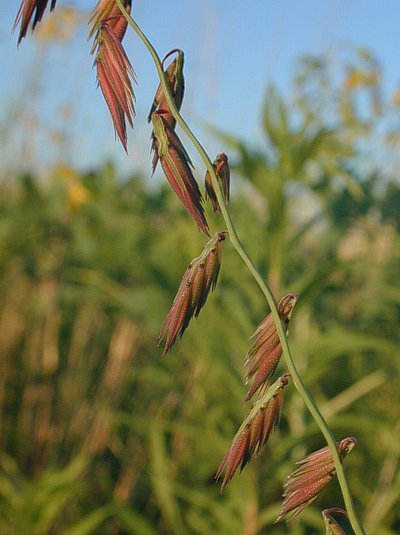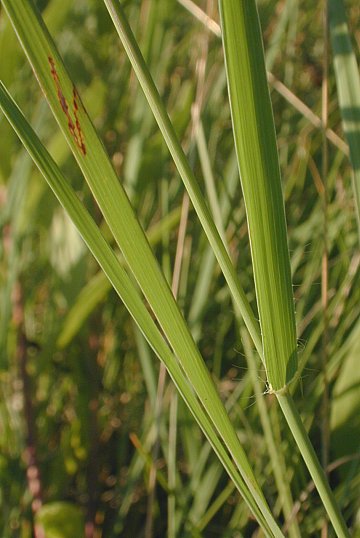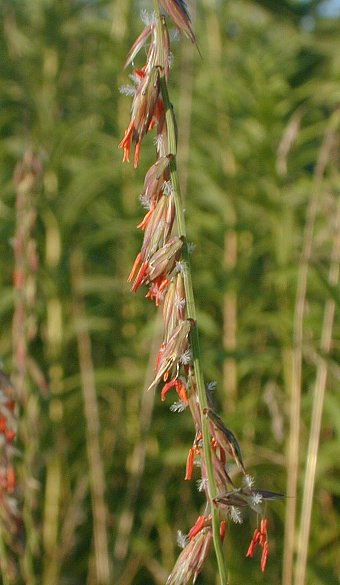Description: This perennial grass is about 2–2½' tall and unbranched. The culms are light green, glabrous, and terete (round in cross-section); later during the autumn after a hard frost, they become light tan. The alternate leaves are more common toward the base of each culm. The leaf blades are up to 8" long and ¼" (6 mm.) across; they are light green to blue-green, mostly hairless, and rough-textured along their margins. However, near the bases of leaf blades, there are often scattered white hairs. The larger leaf blades often have prominent central veins. The open leaf sheaths are light green to blue-green, longitudinally veined, and mostly hairless, although scattered white hairs sometimes occur near their apices and along their upper margins. Each ligule consists of a ring of short fine hairs. The nodes are slightly swollen, rough, and often reddish or brownish green; the portion of the culm near each node may be tinted similarly as well. The culm terminates in a narrow raceme up to 10" long that consists of 25-50 floral spikes that are pendulous; these spikes are pale green, pale red, or greenish red during the blooming period, although they later become light tan.

Each spike is about ½" (12 mm.) long, consisting of 3-7 sessile adjacent spikelets. Each spikelet consists of a pair of linear-lanceolate glumes and a pair of linear-lanceolate lemmas; only one of the lemmas is fertile. Individual spikelets, excluding any awns, are up to 1/3" (8 mm.) long. The glumes have acute tips, while the tips of lemmas are often notched on either side; the infertile lemma has an awn up to ¼" (6 mm.) in length, while the fertile lemma is awnless. The colorful anthers of fertile lemmas are orange to brownish red, while their stigmata are white and feathery. The blooming period occurs from mid-summer to early fall. The spikes of the inflorescence persist into the autumn, after which they fall to the ground in their entirety. Each fertile lemma produces a single grain. Mature grains are about 4.5 mm. long, 1.5 mm. across, narrowly ellipsoid in shape, and light tan. The root system is fibrous and rhizomatous. Side Oats Grama often forms tight bunches of culms from its rhizomes, although it also occurs as scattered plants. In moist areas where there is little competition, it may form a dense sod.

Cultivation:
The
preference is full sun and dry conditions. This grass grows readily in
various kinds of soil, including those containing clay-loam, loess,
gravel, rocky material, and sand. It is quite drought-resistant and
adapts well to gentle or moderate slopes.
Range & Habitat:
The native Side Oats Grama is locally common in sunny upland areas
along the
Mississippi and Illinois Rivers; it is absent in SE Illinois and parts
of central Illinois, and uncommon to occasional elsewhere (see Distribution
Map). Habitats include various kinds of hill prairies, dry
upland prairies (including gravel prairies & dolomite
prairies), thinly wooded bluffs and barrens, limestone glades, and
areas along railroads. This grass is often used in prairie
restorations, from where it occasionally escapes into adjacent areas.
As a result, Side Oats Grama is becoming more common in some areas of
the state.

Faunal
Associations: The
leafhoppers Flexamia
albida, Flexamia pectinata and Laevicephalus
minimus are specialist feeders (oligophages) of Side Oats
Grama (Panzer et al., 2006). Many
grasshoppers feed on this prairie grass (see Grasshopper
Table), as do the stinkbug Moromorpha tetra
and the mealybug Antoninoides nortoni (Rider website, accessed 2009; ScaleNet website, accessed 2014). The larvae of Hesperia dacotae (Dakota Skipper), Hesperia leonardus (Leonard's Skipper), and Hesperia ottoe (Ottoe's Skipper) also feed on it (Natural History Museum website, accessed 2010). Some upland gamebirds and
granivorous songbirds are known to feed on the seeds of Bouteloua
spp. (Grama grasses), but information for Side Oats Grama in
Illinois is unavailable. In Texas and states of the Great Plains, the
McCown Longspur and Wild Turkey eat the seeds of various Grama grasses.
Some hoofed mammalian herbivores, including bison, horses, and cattle,
graze on these grasses readily, including Side Oats Grama. According to
Laughlin (2003), the seeds of Side Oats Grama can cling to the fur of
bison, elk, and other mammals. Thus, these mammals may spread the seeds
into new areas.
Photographic Location:
A prairie at Meadowbrook Park in Urbana, Illinois.

Comments: Side Oats Grama is the only Bouteloua sp. (Grama grass) that is fairly common in Illinois. Two other species, Bouteloua gracilis (Blue Grama) and Bouteloua hirsuta (Hairy Grama), are shorter grasses that are more common in states of the Great Plains. These latter two species have curious racemes of spikes that are shaped like large eye-lashes; they tend to be held horizontally in relation to the ground. Among the grasses of Illinois, the inflorescence of Side Oats Grama is really quite unique as the spaced out spikes tend to droop on one side of the raceme's rachis. As a result, this interesting grass is easy to identify. Side Oats Grama is a warm-season grass with a C4 metabolism (a trait it shares with other Grama grasses). This enables it to tolerate the hot dry summers of the Midwest and other areas further to the west.